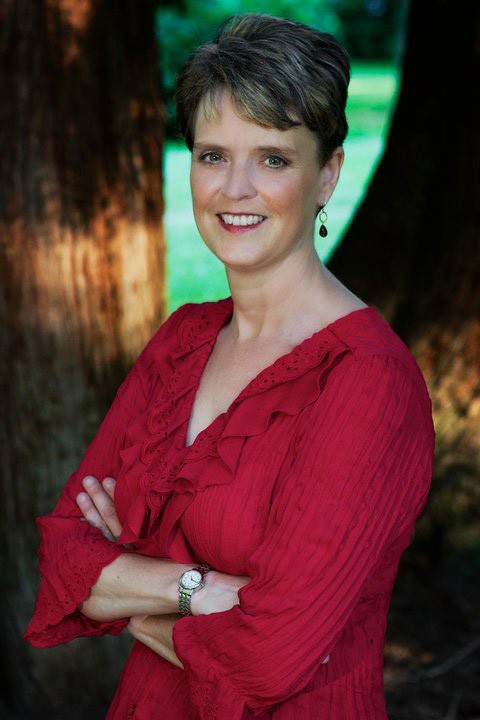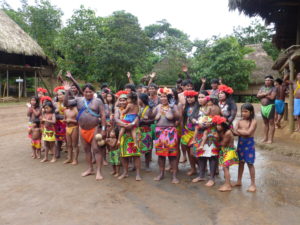

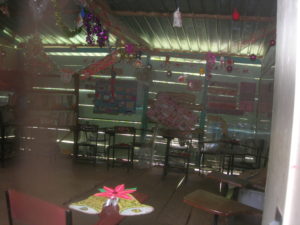
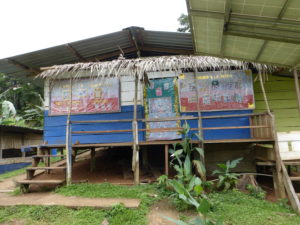
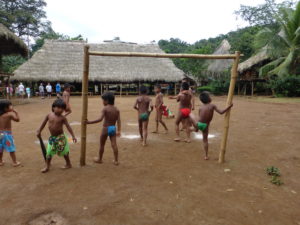

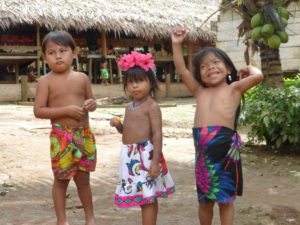 I just returned from ten days in Panama, and the highlight was not the canal, or hiking along the rim of an extinct volcano, where we saw the rare translucent blue butterfly. It was instead a day in an Embera indigenous village in the jungle two hours from Panama City.
I just returned from ten days in Panama, and the highlight was not the canal, or hiking along the rim of an extinct volcano, where we saw the rare translucent blue butterfly. It was instead a day in an Embera indigenous village in the jungle two hours from Panama City.
There are many Embera village tours, but this one was guided by an American woman, Anne, who married into the tribe fifteen years ago, and therefore offers a far more thorough and sensitive day’s immersion than the others, with commentary and history on the culture beyond what any other Western guide can offer:
We arrived by hand-carved dugout canoe, which meandered along jungle-choked rivers and lakes with glimpses of egrets, herons and vultures. (Alas, we saw no monkeys, sloths, jaguars or alligators.)
After preparing us a lunch of fish, fried plantain, pineapple and papaya (so sweet and fresh it just slides down your throat) – served in banana leaf bowls — the tribe members gave us a tour of their flora and fauna. While I watched a boy in a purple loincloth shimmy up a tree for a papaya, the native guide (Flora) described which plants offer medicinal properties for antibiotics, skin irritation, snakebite and birth control. They even have their own green leafy version of Viagra! Flora spoke in Spanish; Anne translated.
Both men and women danced, drummed and displayed their basket weavings and carvings in a market booth, and detailed how they collected and prepared the basket materials.
While the children engaged in lively games of soccer, we also got to peek into their two-room thatched schoolhouse on stilts (to keep snakes and other unwanted jungle life out), all decorated for Christmas. They don’t have internet, but they do have a computer for word processing, and a small shelf of books. They learn in Spanish (the teacher is a soccer champion!), but for the first time, they recently also acquired a qualified teacher who speaks their native Embera language as well. The young people all speak Spanish as well as Embera, whereas the older people just speak Embera.
Three from the 130-member tribe have braved the city to complete high school. These three speak English and handle some of the village’s accounting.
One of my fellow visitors asked permission to hand out candy to the children, which made me a little uncomfortable. She was granted permission and the kids were thrilled. But the village gets visited by tour groups almost daily; daily gifts of candy aren’t going to do much for their teeth or health, and the wrappers will litter their pristine site, I thought. So I asked the guide what would be a better gift. Pencils and books, she said.
I intend to visit again, go on this exact same tour, and bring loads of pencils and (Spanish) books with me next time!
Meanwhile, the guide, Anne, told me something else of interest. When she approached Ten Thousand Villages, “a nonprofit fair-trade organization that markets handcrafted products made by disadvantaged artisans from more than 120 artisan groups in more than 35 countries,” she tried to persuade them to take some of her village’s crafts.
She was told “Panama is not considered a Third World country.” Well, Panama City is not, for sure. It offers slick skyscrapers and gleaming yachts.
But the Embera are seriously discriminated against in the city (considered ignorant savages, says Anne), cannot get jobs there, and therefore remain in their jungle communities, surviving by the food surrounding them, and the tours and crafts – which Anne says are not quite sufficient to live on. (Their communities were “grandfathered in” by the government’s need for a protected watershed around the canal.)
Definitely Third World within Second World. So shame on Ten Thousand Villages!
But worse, she learned that because Ten Thousand Villages sells products through slick catalogs marketed to First World consumers, the organization wants to be assured that products offered can be produced in an identical fashion, so that catalog shoppers know from the photo exactly what they’re getting. The Embera take pride in the fact that every single basket and carving is unique. That ends up working against them! Surely that must be true of indigenous villages throughout the world. Thousand Village shoppers, please write and help the organization (which is well meaning and does great work) get the message that consumers would LOVE products that are each one-of-a-kind and not a precise copy of the photo in the catalog.
https://www.tenthousandvillages.com/contacts/
Ten Thousand Villages
704 Main Street
PO Box 307
Akron, PA 17501-0307
Meanwhile, I’m spending Christmas with my family back here in Canada, before a crackling fireplace and with fond memories of my trip to Panama.
Happy holidays to all, and all the very best in the new year.

